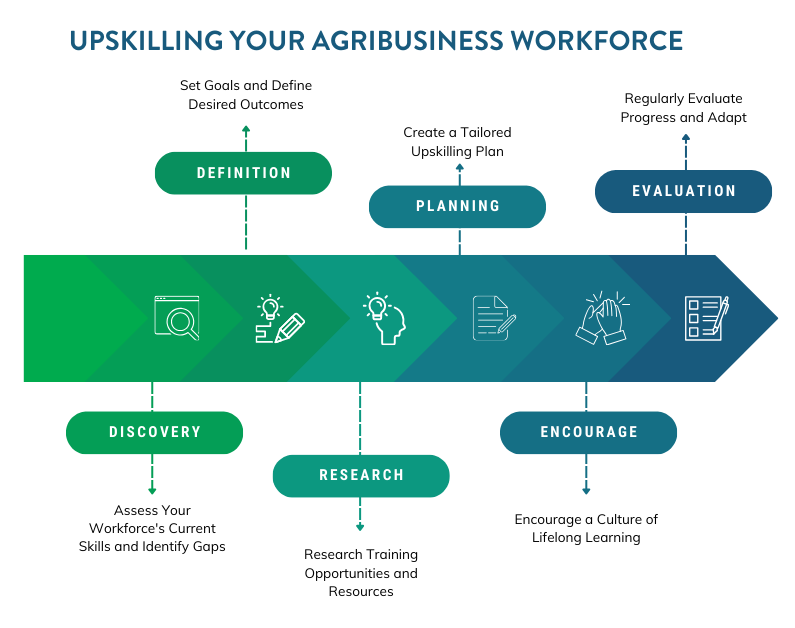A skilled agricultural workforce is vital for long-term success, innovation, and sustainability. Developing the expertise and capabilities of your employees will yield countless benefits, from improved productivity to increased employee satisfaction.

Assess Your Workforce’s Current Skills and Identify Gaps
Begin by evaluating the strengths and weaknesses of your team. This assessment should consider both technical and interpersonal skills required for success in the agribusiness sector. Through identifying the gaps, you gain valuable insights into the areas where upskilling efforts can yield the most significant results.
Where to Start
Skills Matrix – Create a skills matrix or survey to gauge technical and soft skills. Consider tools like self-assessment, peer evaluations, or even external assessments.
Feedback Sessions – Conduct one-on-one or group feedback sessions to understand where team members feel they excel or lack confidence. This can provide valuable insights beyond formal assessments.
Set Goals and Define Desired Outcomes
Establish clear, measurable goals for the upskilling process. Determine which skills need improvement and how these enhancements will contribute to the overall productivity and success of your agribusiness. This may include goals such as increasing technical proficiency, improving problem-solving skills, or fostering teamwork and collaboration.
Where to Start
SMART Objectives – Use the SMART (Specific, Measurable, Achievable, Relevant, Time-bound) framework to define goals. For instance, increasing crop yield by X%, reducing machinery downtime by Y%, etc.
Align with Business Goals – Ensure that the skills you aim to enhance directly tie into the larger objectives of your agribusiness.
Research Training Opportunities and Resources
Explore possible training programs and resources to address skill gaps and suit your workforce’s needs. Consider accredited courses, workshops, online learning platforms and hands-on training from industry specialists. Stay up-to-date on government initiatives and funding options that may support workforce development.
Where to Start
Diverse Learning Modes – Offer a mix of learning styles, such as workshops, online courses, mentoring, on-the-job training, or conferences.
Tailored Programs – Consider customising training to cater to specific roles within the agribusiness. For instance, sales-focused training for marketing teams or specialised technical workshops for field operators.
Create a Tailored Upskilling Plan
Develop a comprehensive plan that outlines the training programs and activities your employees will undertake to achieve the desired outcomes. Consider the various learning styles and preferences of your workforce when designing this plan. Allocate sufficient time, resources, and support to ensure the success of the upskilling process.
Where to Start
Individual Development Plans – Work with team members to create personalised development plans. This shows that you value their growth and helps align training with their career aspirations.
Regular Check-ins – Schedule periodic meetings to discuss progress and make any necessary adjustments to the training plan based on evolving needs or challenges.
Encourage a Culture of Lifelong Learning
Foster an environment that values growth, development, and learning. Encourage open communication and knowledge-sharing among team members, celebrate achievements, and acknowledge progress. Such an atmosphere will help cultivate a passion for continuous improvement within your workforce.
Where to Start
Knowledge Sharing Sessions – Organise regular sessions where team members share insights, lessons learned, or innovative ideas. This can be done through presentations, workshops, or informal discussions.
Reward Continuous Learning – Acknowledge and reward employees who actively engage in learning opportunities. This could be through recognition programs, incentives, or career advancement opportunities tied to skill development.
Regularly Evaluate Progress and Adapt
Quarterly (at least) revisit your upskilling plan and assess progress. Recognise and address any challenges or obstacles that may arise during the process. Regular evaluations and adjustments will help maintain momentum and ensure your workforce remains on track to achieve their upskilling objectives.
Where to Start
Feedback Loops – Use surveys or feedback sessions at different stages of the upskilling process. This helps in understanding the effectiveness of the training and identifies any areas that need further attention.
Adaptability – Be ready to adapt the training plan based on feedback and changing industry trends. Flexibility is key to ensuring the training remains relevant and impactful.
Partner with Industry Experts
Collaborate with industry experts, like The Lucas Group, to support your upskilling initiatives. Leverage our expertise, insights and network to identify the best training opportunities and resources, ensuring a targeted and effective approach to workforce development.
The Lucas Group is committed to helping you strengthen your agribusiness workforce through upskilling. Upholding a strong foundation of expertise and dedication, we take pride in our ability to contribute to the development and success of agriculture in Australia. Embrace these steps and collaborate with us to unlock the full potential of your workforce and set your agribusiness on a path to enduring success.
